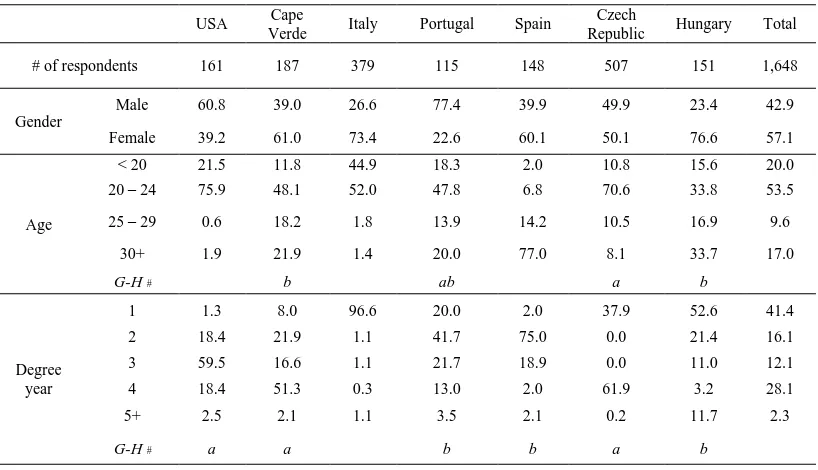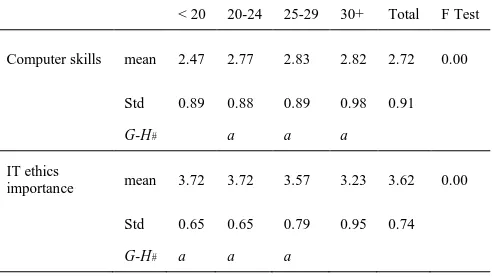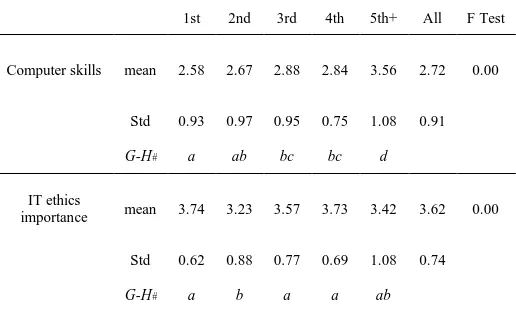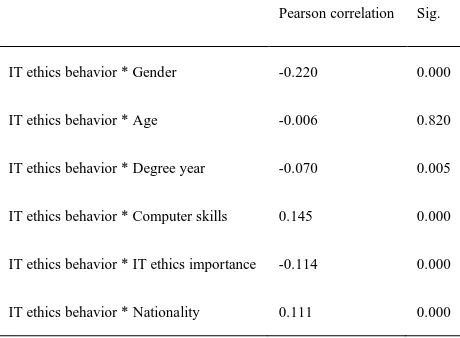What do college students do and think about
IT ethics?
Miloš Ulman
1, Albert L. Harris
2, Cristina Galamba Marreiros
3, Rui
Quaresma
3,
and Murodjon Ganiyev
11 Czech University of Life Sciences Prague, Prague, Czech Republic 2 Appalachian State University, Boone NC, USA
3 CEFAGE, Universidade de Évora, Évora Portugal
ulman@pef.czu.cz
Abstract
Ethics has become a part of many Information Technology (IT) and business classes at colleges and universities. However, the way of teaching IT ethical behavior is sometimes non-effective. Yet, many current ethical issues related to emerging technologies such as big data and Artificial Intelligence (AI) are not considered at all. The paper aims to explore relationships between students’ demographics and inclination towards unethical behavior. The study presents results of a multinational survey conducted with convenience samples of college students at public universities in seven countries from Europe, Africa and North America between October 2017 and January 2018. The survey instrument contained items reporting on perceived importance of IT ethics issues, personal experience with them, and several demographics questions. Data analysis is done with descriptive statistics, one-way ANOVA and F-tests. We conclude that nationality, gender, degree year, computer skills and perception of the importance of IT ethics are significantly related with behavior. Perceptions and behavior of students evolve with the rapid pace of technology, which should be a major concern both for educators and business managers as they would recruit prospective employees from the current students.
1
Introduction
Information privacy issues are omnipresent in digital technology nowadays; starting from massive data breaches from various organizations around the world, to distribution of users’ data to third parties. While the first is often caused by poor security, human error or by a malicious intent, the latter is rather a consequence of intent caused by corporate decision-makers. As the privacy issues costs are growing exponentially – just to name a few, e.g. Facebook to pay $5 billion, the largest civil penalty ever, in settlement with the U.S. Federal Trade Commission for failing to protect user data from third parties
Science Volume 2, 2019, Pages 49–58
(Kelly, 2019), or Equifax required to pay nearly a $600 million penalty for data breach of roughly 150 million Americans in 2017 (Puig, 2019) – it is not just a matter of businesses to rethink their business models and ways of treating others people data, but it is an equal responsibility of educators to shape student’s attitudes and behavior towards ethical issues in digital technology as they would later make these decision as employees.
In the light of the economic and societal consequences of massive violations of information privacy described above, the importance of ethics in organizations and management has become critical (Aasheim, Kaleta, & Rutner, 2019; Larson & Miller, 2009). IT professionals, employees of multinational companies, and students in universities around the world will almost certainly find themselves facing ethical dilemmas sometime in their career. Since the trend toward a globalized economy continues, many students will likely work with individuals of different nationalities. Therefore, it is important to understand how different individuals respond to ethical concerns.
Ethics has become a part of many IT and business classes at colleges and universities. However, the way of teaching ethical behavior towards IT is sometimes narrowed to a list of rules that leave students rather untouched, and yet, as Aasheim et al. (2019) argue, many current ethical issues related to emerging technologies such as big data and artificial intelligence are not considered in college curricula at all. At the same time, students who disregard ethical behavior would probably become employees that disregard ethical behavior too (Elkin-Koren, 2000). The correlation of dishonesty in classroom and workplace has been already proved (Nonis and Swift, 2001; Lawson, 2004). Thus, the concern with ethics education is not only for students as end users, but also as future employees and policy makers in multinational organizations (Elkin-Koren, 2000; Larson & Miller, 2009).
The main objective of this study is to explore relationships between students’ demographics and inclination towards unethical behavior. Multinational corporations work across countries and cultures over long periods of time, so studying students in seven different countries and cultures should contribute to the body of knowledge in understanding the changing landscape of IT ethical behaviors. Therefore, we argue that a logical starting point for this type of research is with students having similar experiences, but who reside in different countries.
2
Literature review
Information ethics is a major concern nowadays involving ethical issues related to intellectual property protection, privacy, data accuracy and accessibility (Chang & Chen, 2017). Mason (1986) published one of the key constructs of information ethics called the PAPA framework in which he formulated four categories of information ethics issues: privacy (what personal information could be revealed to others), accuracy (who is responsible for accuracy of information), property (who owns the information), and accessibility (what information can be accessed and by whom). Despite the fact that the Mason’s piece was written as an opinion citing only two references (Stahl et al., 2014), PAPA framework has become a frequently used base for empirical studies in information ethics research. Moreover, the validity of its framework and described ethical issues has been continuously confirmed (Peslak, 2006; Woodward et al., 2011).
different countries, but Martin & Woodward (2011) confirmed significant differences between US and European students (German, Italian and British). When applied to two very diverse cultures – Chinese and American – the study of information ethics perception’s based on PAPA framework topics revealed a significant influence of national culture (Chang & Chen, 2017).
Bélanger and Crossler (2011) suggest to conduct more studies investigating the why related to privacy, and in multiple countries using non-student populations. Also, they call for research that focuses on design of tools and technologies for the control and protection of information privacy. Smith et al. (2011) recommend to focus on the effect of personality and demographic differences, e.g. (Glover et al., 1997; Hoy & Milne, 2010; Kuo, Lin, & Hsu, 2007; Tahat, et al., 2014), and culture (Harris et al., 2010) on individual’s information ethics as it is not well explored. Further to the calls from the literature cited above we want to examine the following research question: Are there significant differences among students’ IT ethics behavior based on their gender, age, degree year, computer skills, perceived importance of IT ethics and country of residence?
3
Methodology
We used a questionnaire survey and created a convenience sample of college students at public universities in seven countries - Cape Verde, USA, Italy, Portugal, Spain, Hungary and Czech Republic. The survey was administered in classes between October 2017 and January 2018 to 1648 students in the seven countries.
Our survey instrument featured questions regarding personal experience with acts violating IT ethics rules. The questions were with yes/no answer and the list of questions is in the section 7.1. The survey items were originally developed by Harris (2000). The demographics questions included age, gender, and degree year. Moreover, subjects also reported on their view of the importance of IT ethics and their computer skills. They could answer that IT ethics is important to no one (1), college students, but not professionals (2), not for college students, but for professionals (3), or both for college students and professionals (4). The computer skills of student were reported such as following: very little or none (1), somewhat knowledgeable (2), knowledgeable (3), very knowledgeable (4), extremely knowledgeable or expert (5).
Since the sample was built across multiple countries, the survey was created in English, then translated to five different languages spoken in the respective countries, translated back to English, and verified by a native speaker faculty member.
3.1
Data analysis
4
Results
The sample basic demographics is summarized in Table 1. The countries with a lower representation of males in the sample were Spain, Italy, Hungary and Cape Verde, while men had majority in the sample from Portugal and the U.S. An almost equal portion of males and females was present in Czech sample. The age structure was also significantly different across countries. The highest number of students under 20 was in Italy, while the age group 20-24 was the largest in the U.S., Czech Republic and Italy. Students over 30 were most frequent in Czech sample. The U.S., Italy and Spain were significantly different from all other countries in terms of respondents’ age. Portugal and Hungary had a similar age structure, while the age groups of Czechs were similar to Portuguese.
The only country where graduates (4th or higher grade) were in majority was the Czech Republic.
We must note that in our sample European countries have a three-year bachelor programs whereas Cape Verde and the United States require a four-year study in order to receive a bachelor’s degree. A similar structure of degree year was seen between the U.S., Czech Republic and Cape Verde, and then Portugal, Hungary, and Spain. Only Italy differed significantly in the degree year structure of students.
USA
Cape
Verde Italy Portugal Spain
Czech
Republic Hungary Total
# of respondents 161 187 379 115 148 507 151 1,648
Gender
Male 60.8 39.0 26.6 77.4 39.9 49.9 23.4 42.9
Female 39.2 61.0 73.4 22.6 60.1 50.1 76.6 57.1
Age
< 20 21.5 11.8 44.9 18.3 2.0 10.8 15.6 20.0
20 – 24 75.9 48.1 52.0 47.8 6.8 70.6 33.8 53.5
25 – 29 0.6 18.2 1.8 13.9 14.2 10.5 16.9 9.6
30+ 1.9 21.9 1.4 20.0 77.0 8.1 33.7 17.0
G-H # b ab a b
Degree year
1 1.3 8.0 96.6 20.0 2.0 37.9 52.6 41.4
2 18.4 21.9 1.1 41.7 75.0 0.0 21.4 16.1
3 59.5 16.6 1.1 21.7 18.9 0.0 11.0 12.1
4 18.4 51.3 0.3 13.0 2.0 61.9 3.2 28.1
5+ 2.5 2.1 1.1 3.5 2.1 0.2 11.7 2.3
G-H # a a b b a b
# Values with the same alphabets across countries are not significantly different.
Table 1. Sample demographics in percent
Male Female Total Chi-square
Computer skills mean 2.95 2.55 2.72 0.00
Std 0.94 0.85 0.91
IT ethics
importance mean 3.62 3.63 3.62
not sig. different
Std 0.76 0.73 0.74
Table 2 – Gender vs. IT skills and importance of IT ethics
Looking at the differences from the age viewpoint, students under 20 reported significantly lower level of computer skills than older students. On the other hand, the millennials (students under 30) had different perception of IT ethics importance than older generation over the age of 30.
< 20 20-24 25-29 30+ Total F Test
Computer skills mean 2.47 2.77 2.83 2.82 2.72 0.00
Std 0.89 0.88 0.89 0.98 0.91
G-H# a a a
IT ethics
importance mean 3.72 3.72 3.57 3.23 3.62 0.00
Std 0.65 0.65 0.79 0.95 0.74
G-H# a a a
# Values with the same alphabets across countries are not significantly different.
Table 3 – Age vs. IT skills and importance of IT ethics
1st 2nd 3rd 4th 5th+ All F Test
Computer skills mean 2.58 2.67 2.88 2.84 3.56 2.72 0.00
Std 0.93 0.97 0.95 0.75 1.08 0.91
G-H# a ab bc bc d
IT ethics
importance mean 3.74 3.23 3.57 3.73 3.42 3.62 0.00
Std 0.62 0.88 0.77 0.69 1.08 0.74
G-H# a b a a ab
# Values with the same alphabets across countries are not significantly different.
Table 4 – Degree year vs. IT skills and importance of IT ethics
Table 5 presents summarizes results of questions addressing subjects’ ethical behaviors in relation to demographics variable, computer skills, perceived importance of IT ethics and country of residence. There are significant relationships between how students reported on their behavior and those factors, except age.
Gender Age Degree year Computer skills IT ethics importance Country
IT ethics behavior 0.000 0.227 0.000 0.000 0.000 0.000
Table 5 – IT Ethics behavior vs. Gender, degree, age, IT skills, importance of ethics.
Pearson correlation Sig.
IT ethics behavior * Gender -0.220 0.000
IT ethics behavior * Age -0.006 0.820
IT ethics behavior * Degree year -0.070 0.005
IT ethics behavior * Computer skills 0.145 0.000
IT ethics behavior * IT ethics importance -0.114 0.000
IT ethics behavior * Nationality 0.111 0.000
Table 6 – Correlations between IT ethics behavior and demographics factors.
5
Discussion
We analyzed differences among groups with different sociodemographic characteristics and found that in what concerns gender, significant differences between men and women were revealed in confidence in computer skills (Table 2) and IT ethics behavior (Table 5-6). Men reported unethical acts more frequently than women but did not view importance of IT ethics significantly different than females. As for gender differences and privacy, which is one of the facets of IT ethics, Peslak (2006) confirmed that women, in a population of 219 US college students, put more importance on privacy and accuracy than men, which is consistent with our findings. However, Peslak’s survey provided relatively small sample and contained only four questions concerning IT ethical issues. Furthermore, Glover et al. (1997) confirmed with a sample of 367 US college students that women made more ethical decisions than men and, at the same time, that years of experience also correlated with higher levels of ethical behavior. The same conclusion, from a sample of 841 US college students, was attained by Kini et al. (2000) regarding attitudes to software piracy. In a sample of 589 Facebook users between 18-24 years old from the US, Hoy and Milne (2010) found that women were more concerned about data usage beyond its original purpose and about behavioral advertising techniques in social networks.
Other empirical studies outside the US with non-student populations, however, provided no significant evidence for gender differences in terms of privacy, such as is the case of Taiwan (Kuo et al., 2007) or Sweden (Bergström, 2015). Moreover, Bergström (2015) notes that perception of privacy issues has certainly evolved from the early 2000s. Nevertheless, Tahat et al. (2014) conducted a survey among 225 IT professionals in the U.S. and Middle East regarding their ethical attitudes and confirmed gender differences in both geographical areas. In conclusion, we can state that gender has an impact on behavior concerning IT ethics especially among college students.
be a significant gap between perceived level of computer skills and the actual one which poses further issues for educators (Maryška, 2012), employers, but also small business owners (Tyrychtr, 2017).
The differences in reported IT skills among age groups (Table 3) were significant, having younger students reported lower confidence in computer skills whereas the older ones reported higher confidence. Moreover, the older students might more likely have previous working experience, but we did not ask about it in the survey. Glover et al. (1997) reported that the age of respondents was not a predictor of ethical decision-making among students, and posited that experience makes people more aware of the ethical dimension of decisions. Kini et al. (2000) concluded that there was a tendency among younger people to see certain issues such as software privacy as less problematic. Another survey of 401 college students from the U.S. and Middle East (Almasri & Tahat, 2018) showed that graduate students tend to recognize more IT ethical issues than undergraduate students. In our survey, there were minor differences in IT ethics behavior between age groups, but not statistically different, whereas the differences between degree years were statistically different. However, the biggest difference was between 4th year students who represented more than 28 % of the sample and who
reported significantly lower number of unethical activities then their younger fellows.
Following the findings of similar studies, it is no surprise that country of origin had a significant relationship with and effect on the subjects’ IT ethics behaviors. Most of the cited studies tried to explain the uncovered differences on the basis of economic, technological and/or cultural traits. However, no common explanation for country differences on IT ethical thinking could be found on the mentioned researches, since each study analyzed a different pool of countries with different approaches. Moreover, also in line with our results, studies by Harris et al., (2010), Martin & Woodward (2011), Tahat et al. (2014) included a variety of ethical issues, concluded that differences between countries were not constant over all the topics analyzed.
In summary, we can state that in order to find a justification for differences on IT ethics behavior, we cannot focus only on demographic aspects of the respondents such as gender, age and degree year. At the same time, among the college student populations, belief in the importance of IT ethics and computer skills influenced to some extent the individuals’ behavior. Investigating national culture as a factor of IT ethics perceptions and behavior would need a robust research model based on the Theory of Planned Behavior, Theory of Reasoned Action, Kohlberg’s CMD model, or Rest’s ethical decision-making model to yield reliable results.
6
Conclusion
By conducting the presented study, we want to inform teachers and business managers on what students think about IT ethics in general and how they behave. Since we used a convenience, yet diverse, sample of student populations from seven countries we could not generalize our findings.
Given the rapid changes in technology, both educators and managers need to follow the changes in how young learners perceive and act since those who study today might become new hires tomorrow. We believe that by understanding differences in students’ perceptions of IT ethics issues, educators will be able to better adapt the curricula in order to address up to date ethical issues and, eventually influence the formation of students’ attitudes towards those issues. At the same time, managers need to understand how their future hires would react in ethical dilemma situations and how they perceive the sensitivity of various ethical issues as these factors may have direct implications for their businesses.
Acknowledgements. Authors would like to thank to all colleagues who helped with data collection. This work was supported by the Internal Grant Agency of the Faculty of Economics and Management, Czech University of Life Sciences Prague under Grant number 2019A0010; and the National Funds of the FCT – Portuguese Foundation for Science and Technology within the project «UID/ECO/04007/2019».
7
Appendix
7.1
List of questions reporting on behavior towards IT ethics issues
Have you ever used or sold shareware illegally (without registering it)?
Have you ever purchased a legal copy of software and given the old version to someone else? Have you ever changed data that someone else would rely on?
Have you ever used software in an illegal manner?
Have you ever given someone unauthorized access to a computer? Have you ever knowingly released a virus or worm into any system? Have you ever made an illegal copy of software?
Have you ever downloaded songs or movies without paying for them when required?
References
Aasheim, C., Kaleta, J., & Rutner, P. (2019). Assessing IT Students’ Intentions to Commit Unethical Actions. Journal of Computer Information Systems, 1–10. https://doi.org/10.1080/08874417.2019.1584544
Almasri, N., & Tahat, L. (2018). Ethics Vs IT Ethics: a Comparative Study between the USA and the Middle East. Journal of Academic Ethics, 16(4), 329–358. https://doi.org/10.1007/s10805-018-9310-9
Bélanger, F., & Crossler, R. E. (2011). Privacy in the digital age: a review of information privacy research in information systems. MIS Quarterly, 35(4), 1017–1042. https://doi.org/10.2307/41409971
Bergström, A. (2015). Online privacy concerns: A broad approach to understanding the concerns of different groups for different uses. Computers in Human Behavior, 53, 419–426. https://doi.org/https://doi.org/10.1016/j.chb.2015.07.025
Chang, C. L., & Chen, J. Q. (2017). The information ethics perception gaps between Chinese and American students. Information Technology & People, 30(2), 473–502. https://doi.org/http://dx.doi.org/10.1108/ITP-08-2014-0181
Elkin-Koren, N. (2000). The privatization of information policy. Ethics and Information Technology,
2(4), 201–209.
Glover, S. H., Bumpus, M. A., Logan, J. E., & Ciesla, J. R. (1997). Re-examining the Influence of Individual Values on Ethical Decision Making. Journal of Business Ethics, 16(12/13), 109–119. https://doi.org/10.1007/978-94-009-1475-9_10
Harris, A. L. (2000). IS ethical attitudes among college students: A comparative study. In Proceedings
of ISECON (pp. 801–807). Citeseer.
Information Systems 2010, AMCIS 2010 (Vol. 3, pp. 1886–1895). (1)Walker College of Business, Appalachian State University.
Hoy, M. G., & Milne, G. (2010). Gender Differences in Privacy-Related Measures for Young Adult Facebook Users. Journal of Interactive Advertising, 10(2), 28–45. https://doi.org/10.1080/15252019.2010.10722168
Jeff Smith, H., Dinev, T., & Xu, H. (2011). Information privacy research: An interdisciplinary review.
MIS Quarterly: Management Information Systems, 35(4), 989–1015.
https://doi.org/10.2307/41409970
Kelly, M. (2019, July 24). FTC hits Facebook with $5 billion fine and new privacy checks.
Kini, R. B., Rominger, A., & Vijayaraman, B. S. (2000). An empirical study of software piracy and moral intensity among university students. Journal of Computer Information Systems, 40(3), 62– 72.
Kuo, F.-Y., Lin, C. S., & Hsu, M.-H. (2007). Assessing Gender Differences in Computer Professionals’ Self-Regulatory Efficacy Concerning Information Privacy Practices. Journal of Business Ethics,
73(2), 145–160. https://doi.org/10.1007/s10551-006-9179-1
Larson, D., & Miller, K. W. (2009). Ethics in the IT classroom: Why and how? Journal of Information
Ethics, 18(2), 38–49. https://doi.org/10.3172/JIE.18.2.38
Lawson, R. A. (2004). Is classroom cheating related to business students’ propensity to cheat in the “real world”? Journal of Business Ethics, 49(2), 189–199. https://doi.org/10.1023/B:BUSI.0000015784.34148.cb
Martin, N. L., & Woodward, B. (2011). Computer Ethics of American and European Information Technology Students: a Cross-Cultural Comparison. Information & Management, 12(May), 78– 87. https://doi.org/10.1016/0378-7206(86)90027-3
Maryška, M. (2012). ICT specialist skills and knowledge – business requirements and education.
Journal on Efficiency and Responsibility in Education and Science, 5(3), 57–172.
https://doi.org/10.7160/eriesj.2012.050305
Nonis, S., & Swift, C. O. (2001). An Examination of the Relationship Between Academic Dishonesty and Workplace Dishonesty: A Multicampus Investigation. Journal of Education for Business,
77(2), 69–77. https://doi.org/10.1080/08832320109599052
Peslak, A. R. (2006). PAPA revisited: A current empirical study of the Mason framework. Journal of
Computer Information Systems, 46(3), 117–123.
Puig, A. (2019). Equifax Data Breach Settlement: What You Should Know.
Stahl, B. C., Eden, G., Jirotka, M., & Coeckelbergh, M. (2014). From computer ethics to responsible research and innovation in ICT: The transition of reference discourses informing ethics-related research in information systems. Information & Management, 51(6), 810–818. https://doi.org/https://doi.org/10.1016/j.im.2014.01.001
Tahat, L., Elian, M. I., Sawalha, N. N., & Al-Shaikh, F. N. (2014). The ethical attitudes of information technology professionals: a comparative study between the USA and the Middle East. Ethics and
Information Technology, 16(3), 241–249. https://doi.org/10.1007/s10676-014-9349-2
Tyrychtr, J. (2017). Economic Value of Information Systems in Agriculture: Cohesion and Coupling of Information Elements. AGRIS On-Line Papers in Economics and Informatics, 9(665-2017– 2086), 71–79. https://doi.org/10.7160/aol.2017.090307
Woodward, B., Martin, N. L., & Imboden, T. (2011). Expansion and Validation of the PAPA Framework. Information Systems Education Journal, 9(3), 28–34.
Yates, D., & Harris, A. L. (2011). International Ethical Attitudes and Behaviors: Implications for Organizational Information Security Policy. In M. Dark (Ed.), Information Assurance and



